March 4, 2016
Air Date: March 4, 2016
FULL SHOW
SEGMENTS
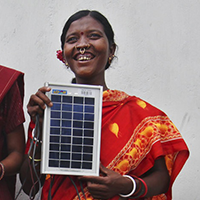
India’s Solar Power Plans Hobbled by US
View the page for this story
In response to a US complaint the World Trade Organization has found that some provisions in India’s National Solar Mission violate international trade rules. Friends of the Earth’s Sam Cossar-Gilbert tells host Steve Curwood how the ruling could undermine India’s pledges to cut global warming emissions under the Paris Climate Agreement and calls into question the extent of the US commitment to help developing nations fight climate change. (08:00)

Beyond the Headlines
/ Peter DykstraView the page for this story
In this week’s trip beyond the headlines, Peter Dykstra tells host Steve Curwood about the indictment of three executives for the Fukushima Nuclear meltdown, America’s first climate change “refugees” from Louisiana and the shutdown of the last commercial whaling station in the US, 45 years ago. (04:15)
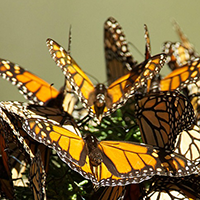
Monarch Butterflies on the Rebound
View the page for this story
As recently as the mid 1990s, a billion or more Monarch butterflies fluttered through US and Canadian meadows in the summer and headed to forests in central Mexico in the winter, but habitat loss, pesticides and climate change have endangered their population. Host Steve Curwood discusses a recent survey indicating a rebound in Monarchs with Tierra Curry, Senior Scientist with the Center for Biological Diversity, and learns what the US and Mexico are doing to ensure that the species continues to recover. (06:35)
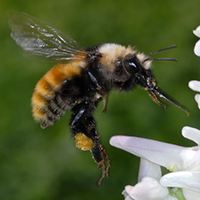
Pollinators In Trouble Worldwide
View the page for this story
One out of every three bites of our food comes to us thanks to pollinators like bees, butterflies, and birds. But a new UN-sponsored report details the threats that pollinators are facing around the world, from pesticides to habitat destruction. One of the authors David Inouye, a biology professor from the University of Maryland, discusses the findings with host Steve Curwood. (06:45)
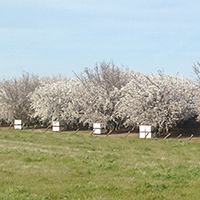
The Great California Almond Pollination
/ Emmett FitzGeraldView the page for this story
Eighty percent of the world’s almond supply is grown in California’s Central Valley. Those nut trees need a lot of water and also honeybees to pollinate the blossoms. Living on Earth’s Emmett Fitzgerald visits the orchards with an almond farmer and a migratory beekeeper who have been working together for over 30 years. (07:15)
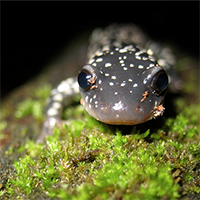
Good Bacteria Could Save Amphibians
/ Helen PalmerView the page for this story
Fighting the fungal diseases that have killed millions of frogs and other amphibians is a top priority, and new research suggests natural soil bacteria might provide protection. UMass Boston biology professor Doug Woodhams tells Living on Earth’s Helen Palmer how they work, and might help other species threatened by these illnesses. (07:30)

Sustainable Coffee Keeps the Planet in the Black
View the page for this story
Growing coffee often leads to deforestation, but it doesn’t have to be that way. Host Steve Curwood and Conservation International CEO Peter Seligmann discuss how the Sustainable Coffee Challenge uses marketing strategies and a wish to cut costs to shift production towards a model, which saves forests, strengthens supply chains and fuels local economies. (07:15)
Show Credits and Funders
Show Transcript
HOST: Steve Curwood
GUESTS: Sam Cossar-Gilbert, Tierra Curry, David Inouye, Doug Woodhams, Peter Seligmann
REPORTERS: Emmett FitzGerald, Peter Dykstra, Helen Palmer
[THEME]
CURWOOD: From Public Radio International, this is Living on Earth.
[THEME]
CURWOOD: I'm Steve Curwood. Installing 100 gigawatts of solar is part of India’s plan to cut global warming emissions, but the World Trade Organization has ruled the plans to buy locally made panels are illegal.
COSSAR-GILBERT: The ink is barely dry on the Paris climate accord and yet we're seeing in this action that trade trumps climate. A number of developing countries see local green jobs as a key way to stimulate the green economy and this ruling really goes against it.
CURWOOD: Also, when almond orchards bloom in California, beekeepers bring their hives.
GRISSOM: You can see the trucks coming from out of state. They come from as far as Florida. The guy right here is from Idaho, my other friend over there he is from Arkansas, they come from everywhere, Mississippi. The almonds is the bread and butter. The other is just, if you make any honey it’s bonus.
CURWOOD: That and more this week, on Living on Earth. Stick around.
[NEWSBREAK MUSIC: Boards Of Canada “Zoetrope” from “In A Beautiful Place Out In The Country” (Warp Records 2000)]
ANNOUNCER: Support for Living on Earth comes from United Technologies – innovating to make the world a better, more sustainable, place to live.
[THEME RETURN]
India’s Solar Power Plans Hobbled by US

India places its hopes in solar technology to power the roughly 20% of its citizens who lack access to electricity. (Photo: Abbie Trayler-Smith / Panos Pictures / Department for International Development, Flickr CC BY-NC-ND 2.0)
CURWOOD: From the Jennifer and Ted Stanley studios at the University of Massachusetts Boston and PRI, this is Living on Earth. I’m Steve Curwood. The World Trade Organization has ruled that India may not protect local production of solar energy cells. The ruling came in response to a complaint from the United States, saying that India’s requirement that ten percent of its solar panels be produced domestically amounts to restraint of trade. The WTO case raises serious doubts about the Obama Administration’s commitment under the Paris Climate Agreement to help developing countries use climate-safe energy to stimulate local jobs and economic development. It also appears to contradict promises made by the President in January of 2015 in New Delhi when he visited Indian Prime Minister Narendra Modi.
OBAMA: We will continue to pursue export reforms so that we can advance more high-tech collaborations with India. I’m also pleased that we agreed to a number of important steps to promote clean energy and to confront climate change. We very much support India’s ambitious goal for solar energy, and stand ready to speed this expansion with additional financing.
CURWOOD: India plans to install 100 gigawatts of solar power in the next six years, as part of its commitment to the Paris Climate Summit where Prime Minister Modi launched what’s called the International Solar Alliance.
MODI: The vast majority of humanity is blessed with generous sunlight round the year. Yet many are also without any source of power.
CURWOOD: The alliance would mobilize a trillion dollars by 2030 to harness the sun’s power for the developing world and help build new clean energy economies.
MODI: This is an alliance that brings together developed and developing countries, governments and industries, laboratories and institutions, in a common enterprise.
CURWOOD: But now this ruling against India by the World Trade Organization casts a shadow over the country’s hopes for a homegrown solar economy. India has not said whether it will appeal the ruling. To understand what’s going on here we called up Sam Cossar-Gilbert of Friends of the Earth. Welcome to Living on Earth, Sam.
COSSAR-GILBERT: Thanks for having me.
CURWOOD: Why in your view is United States objecting to India's national solar mission and taking it to the World Trade Organization and getting it validated?
COSSAR-GILBERT: So the United States has brought the case in the WTO against India’s solar program because the solar program, a very small part of the solar program contains what's known as a domestic content clause which says that, again, a small number of the solar panels, the millions of solar panels that will be brought into India over the next two years need to be made in India because the Indian government sees clean energy jobs as an important part of their development transition, and the US and the WTO has a problem with the domestic content clause and says that it violates trade laws. It's quite ironic because the United States also, a number of states within the US use a similar buy-local clause in their solar programs because we know that clean energy jobs are an important part of the transition.
CURWOOD: Sam, on what grounds do the WTO reject India's argument defending its domestic content restrictions?
COSSAR-GILBERT: So, India also made...they tried to use the defense that it was part of India's obligation to the UNFCCC and other UN sustainable initiatives. The domestic content was part of a broader sustainability initiative and the WTO still found that it was discriminatory.

A solar charging station in the Narsindi district of India. Currently, much of India relies on coal for power. (Photo: Hiroo Yamagata, Flickr CC BY-SA 2.0)
CURWOOD: The international climate negotiation process emphasizes the need for technology transfer from developed countries and their technology to less developed countries. How does this action compare to that desire and indeed goal of, say, the Paris climate agreement?
COSSAR-GILBERT: So, I think the ink is barely dry on the Paris climate accord and yet we're seeing in this action that trade trumps climate. A number of developing countries see local green jobs as a key way to stimulate the economy and this ruling really goes against it, and we’re also worried that agreements like the TPP, which is a much more comprehensive trade agreement that the US and 12 other countries in the Pacific are involved in, goes a lot further and will really stop some of the technology transfer occurring in the same way the disagreement with the WTO ruling is undermining India's solar program.
CURWOOD: For the record, the TransPacific Partnership (TPP) is the massive new trade bill that's pending on Capitol Hill here in United States. We contacted the United States trade representative to ask what the US government's view was on this and the US says it brought this action because the US can export cheaper solar cells than can be made in India and therefore that raises the cost of generating clean energy in India. Your response?
COSSAR-GILBERT: That governments should be free to use commonsense climate policy in the way that they see fit. If India or other developing countries cannot enact policy to support the creation of domestic industries, it's much much less likely that these policies will see the light of day. Supporting infant industries to develop like the Indian solar industry is a well-known economic development model. India is only using a small percentage of the program as domestic content, around 10 percent, and India continues to import in 2014 about over 100 million solar panels. So that argument is, I think, self-interested and in the case of India it is real hypocrisy from the US government that uses similar policies to support their industry.
CURWOOD: Now, this ruling, of course, could be appealed. If it is not appealed or an appeal is unsuccessful. How do you think India's national solar mission will be forced to change its program?
COSSAR-GILBERT: In terms of India solar panel program moving forward, it will still continue and it will be up to the Indian government to decide. In WTO rulings in the past, if India does not comply they may face sanctions or will reach a settlement with the United States.
CURWOOD: So many see this action by the World Trade Organization against India at the behest of the United States as a huge contradiction with the Paris climate agreement. How might this be reconciled? How could trade policy be reformed to loosen barriers towards local renewable growth in developing countries?
COSSAR-GILBERT: I think the first thing the WTO could do is not stand in the way, and this is what we're seeing here. A developing nation has put up a massive policy for increasing renewable energy and the WTO's standing in the way. First thing that trade policy needs to do is get out of the way of a sustainable future, and then we need to start working on trade policy, that supports local and regional integration, supports technology transfer and good clean jobs.
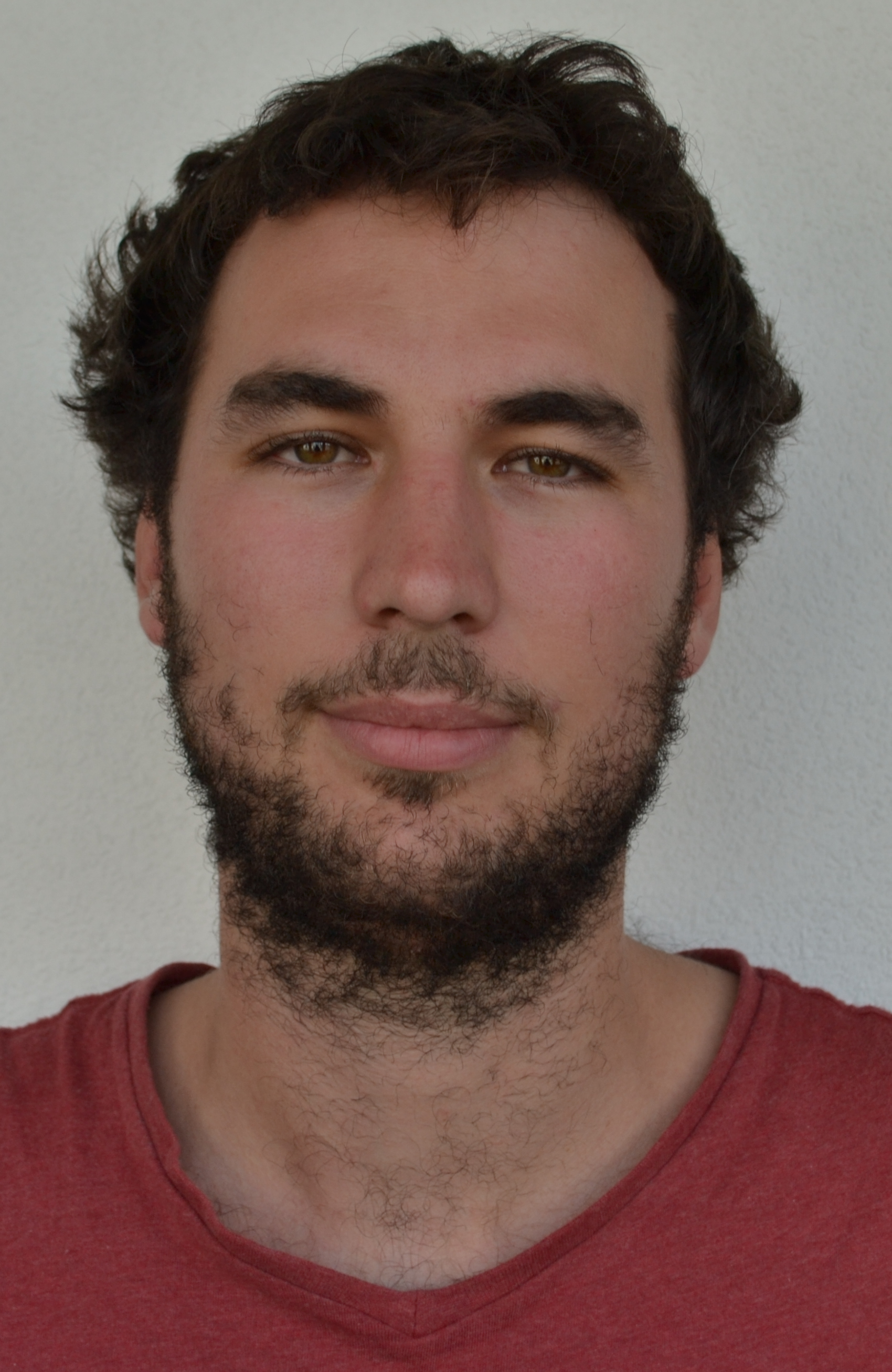
Sam Cossar-Gilbert, the Resisting Neoliberalism Coordinator for Friends Of The Earth International (Photo: courtesy of Sam Cossar-Gilbert)
CURWOOD: Sam, given the whole existential threat of climate disruption where India stands, I imagine you're simply scratching your head.
COSSAR-GILBERT: I mean that's it. We spend a long time lobbying at the national level, lobbying at the regional level in the UN institutions and to have another international institution, the WTO come out and challenge one of the developing countries key pledges is really shocking.
CURWOOD: Sam Cossar-Gilbert is with Friends of the Earth International. Thank you so much effort, Sam, for taking the time with us today. Thanks.
COSSAR-GILBERT: Thanks a lot.
CURWOOD: We called up the US Trade Representative’s Office to ask why, when the US is so firmly on record as a leader in trying to control global warming emissions, we would throw this particular monkeywrench in the works. Spokesman Andrew Bates sent a detailed explanation, and a statement that read, in part:
“The single, specific policy that the United States challenged at the WTO, which comprised one small portion of the National Solar Mission of India, discriminated against American solar exports and, required the use of more expensive and less efficient solar equipment – thereby raising the cost of generating clean energy across India."
There’s more at our website LOE.org.
Related links:
- U.S. Trade Representative Press Release on India's Domestic Solar Supports
- Burgeoning Solar In India
- India National Solar Mission
- About Sam Cossar-Gilbert and Friends of the Earth, Australia
Beyond the Headlines

IAEA experts depart Unit 4 of TEPCO's Fukushima Daiichi Nuclear Power Station on April 17, 2013 as part of a mission to review Japan's plans to decommission the facility. Three of TEPCO’s executives were indicted on charges of negligence for this environmental disaster. (Photo: Greg Webb / IAEA, Flickr CC BY-SA 2.0)
CURWOOD: And now let’s join Peter Dykstra of DailyClimate.org and Environmental Health News, that’s EHN.org to go beyond the headlines. He’s on the line from Conyers, Georgia. What have you found, Peter?
DYKSTRA: There’s big news on the environmental crime beat this week. The former CEO and two top Vice Presidents at Tokyo Electric Power, better known as TEPCO, were indicted on charges of negligence for the catastrophe at the Fukushima Nuclear plant back in 2011.
CURWOOD: Yeah, I think there’s still some areas around that zone that people can’t go back to, right?
DYKSTRA: That’s right. They’ve slowly begun to lift the evacuation orders nearly five years later, but even in places that are cleared for people to live in, not everybody wants to go back. Prosecutors had declined to indict the former TEPCO bosses twice before, but a citizens’ commission forced their hand, and as they say, the third time’s a crime.
CURWOOD: Or at least an indictment.
DYKSTRA: For which the three are expected to plead not guilty when the trial gets underway several months from now.
CURWOOD: So what would the sentence be if in fact they’re found guilty?
DYKSTRA: It could be a fairly long prison stretch – potentially up to five years, or a not-so-big fine of a million yen, which is under $9,000.
CURWOOD: What! I mean, they trash this whole part of Japan and the fine will be less than $9,000? I mean, you can’t even buy a nice Toyota, used Toyota, for that money.
DYKSTRA: That’s right.
CURWOOD: So, what’s next?
DYKSTRA: Well, Americans have always had the luxury of thinking of “refugees” as literally a foreign term from places like Darfur or Syria. But along the vanishing Louisiana coast, members of a French-speaking Indian tribe have officially become America’s first climate change refugees as their home on the Isle de Jean Charles washes away.

Residents of Isle de Jean Charles in Louisiana, like the Biloxi-Chitimacha-Choctaw tribe, are losing their land to rising seas and need to relocate. (Photo: Karen Apricot, Flickr CC BY-SA 2.0)
CURWOOD: How many of them? And what makes this official?
DYKSTRA: Well, it’s official because they’ve received - there are about 230 people in the tribe - a $48 million federal grant to aid in their relocation. They don’t know where they’re going yet, but they can’t stay where they are for much longer.
CURWOOD: No, well, they certainly can’t. I mean, we’ve reported on the crisis in Louisiana – it’s partly climate, but then of course, the oil and gas industry put in this web of pipelines and channels all along the bayous and the coast there. And the Mississippi River is now channelized so the sediment that used to rebuild that land is now getting flushed out to sea.
DYKSTRA: That’s right. There’s also subsidence, where marshy land is literally sinking while seas are rising.
CURWOOD: And where else is this going on?
DYKSTRA: Well, places like Smith Island in Chesapeake Bay. There’s another problem in Alaskan coastal villages like Shishmaref and Kivalina. The sea ice that shields these towns from winter storms isn’t always there anymore. Climate change and sea level rise aren’t the sole culprits, but they’re making a bad situation worse and making it happen sooner.
CURWOOD: Alright, Peter, what do you have for us this week from the history vaults?
DYKSTRA: 45 years ago this week, the last commercial whaling station in the United States shut down for good. It was in Richmond, California on San Francisco Bay, where the Del Monte Fishing company – that’s no relation to the famous food brand – ran three converted Navy ships out within a 100-mile radius of the Golden Gate to catch humpback, sperm and finback whales until the Secretary of Commerce, Maurice Stans, yanked their whaling permit and a year after that in 1972, the Marine Mammal Protection Act outlawed all commercial whaling.
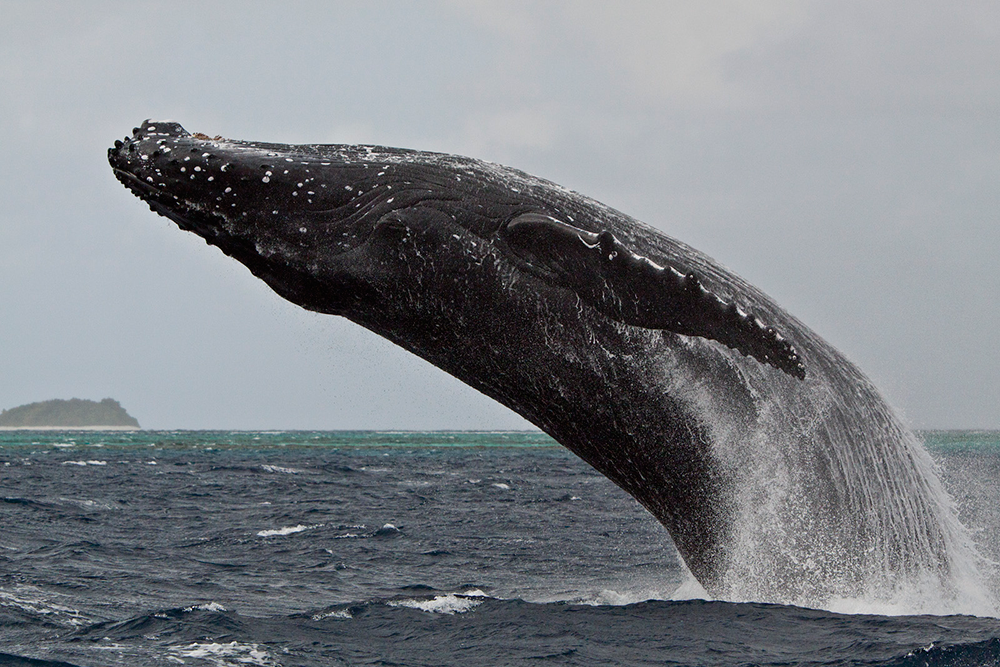
A Humpback whale breaches. (Photo: Colin Baxter Photography)
CURWOOD: How many whales were they killing?
DYKSTRA: They averaged about 170 whales a year. They converted them into pet food, chicken feed and feed for minks on fur ranches.
CURWOOD: And today how are the whales doing?
DYKSTRA: Humpbacks, finbacks, sperm whales, blue whales, northern right whales and other species are still on the US Endangered Species List. There are ship collisions, fishing gear entanglement, pollution, and of course Japan still sends ships down to the Antarctic to hunt finback whales and non-endangered minke whales under the thin guise of “research.” You know, there’s a link between Japan’s whaling and that tsunami that caused the Fukushima disaster.
CURWOOD: Oh, what’s that?
DYKSTRA: The whaling fleet loses money ever year, but back in 2011, they got $29 million dollars in tsunami disaster aid to stay afloat.
CURWOOD: So, we're back to Fukushima again. Peter Dykstra is with Environmental Health News, that’s EHN.org and DailyClimate.org. Thanks, Peter. We’ll talk to you again soon.
DYKSTRA: Alright, Steve, thanks a lot. Talk to you soon.
CURWOOD: And there’s more on these stories on our website, LOE.org.
Related links:
- Former TEPCO bosses indicted over Fukushima meltdown
- Louisiana Tribe Officially Becomes America's First Climate Refugees
- Losing Ground in Louisiana
- Climate Change Takes A Village As The Planet Warms, A Remote Alaskan Town Shows Just How Unprepared We Are
- Smith Island, threatened by rising water and dwindling population, aims to shore up its future
- The Last Whaling Station
- Whaling station news stories from March 2, 1971
- Japan uses Fukushima money to prop up whaling fleet
- Controversial Japanese Whaling
[MUSIC: Takeharu Kunimoto and The Last Frontier, "Appalachian Shamisen," on Dirt Music, indie publication/not commercially available]
CURWOOD: Just ahead, some good news for a popular and pretty butterfly. Stay tuned to Living on Earth.
[CUTAWAY MUSIC: Gavriel Lipkind/Alexandra Lubchansky, "Tango," on Miniatures & Folklore, Isaac Albeniz/arr.Kreisler/Lipkind, Lipkind Productions/Edel Classics]
Monarch Butterflies on the Rebound

Monarchs cluster tightly, so researchers can estimate the overall population size based on the amount of forest the butterflies cover. (Photo: skeeze, Pixabay public domain)
CURWOOD: It’s Living on Earth, I’m Steve Curwood. There’s good news for Monarch butterflies which migrate north from forests in Central Mexico in the spring and back south from the US and Canada in the fall. When researchers began tracking the Monarch populations during their stay in Mexico 20 years ago they found that numbers were dwindling, and recently they went so low it seemed the beautiful butterflies were headed for extinction. Habitat loss, illegal logging, and bad weather are all implicated in their decline, but now a new survey of the Monarch wintering grounds in Mexico offers some hope. For more details we called up Tierra Curry, a Senior Scientist with the Center for Biological Diversity. Welcome to Living on Earth.
CURRY: Thank you so much or having me on the show.
CURWOOD: So, how excited are you that Monarch numbers here in North America seem to be going up?
CURRY: I am really relieved, but I'm also very cautious because the reason the numbers are up three times this year was perfect weather, and so I'm hopeful that we'll continue to have good weather, but the Monarchs are so vulnerable to the weather that we need to get their population to a much bigger size so they can be resilient to all the threats they're facing.
CURWOOD: Now, researchers started looking at Monarch colonies back in the '90s. How big were they then?

The migration of Monarchs takes several generations to complete. During their time in the US, Monarchs cover 48 states. (Photo: USFWS, public domain)
CURRY: You know, back in the mid-90s, they estimate that there were from 700 million to a billion Monarchs, and before people started counting when there were wild prairies and lots of forests in Mexico, there would have been even more Monarchs, so historically there probably were a billion, but then three years ago that number fell down to 25 million. And that caused utter panic because that's so few Monarch butterflies so everyone's breathing a sigh of relief that there's 150 million now, but the Monarchs are so vulnerable to the weather that we need to get their population to a much bigger size.
CURWOOD: Talk to me about the territory back when they were a billion. How much forest did they cover?
CURRY: So, monarchs are amazing. They do this multigenerational migration from Canada and the Northern United States at the end of summer all the way down to 12 mountaintops in central Mexico. The monarchs cover 45 acres and so 18 hectares of forest that winter. They cluster really densely on the trees and the trees turn orange because the conditions there are perfect for them to spend the winter. It's not so hot that they wake up and burn off all their fat, and it's not so cold that they freeze. And because the area is so small, they're really vulnerable to bad weather threats. Back in 2002, 500 million Monarchs were killed in a winter storm, and 500 million Monarchs is more Monarchs than we currently have in the whole population.
CURWOOD: How small did the territory get?

Size of overwintering area in hectare of the Monarch Butterfly (Danaus plexippus) in Mexico 1993/94-2013/14, based on the data of Eduardo Rendón-Salinas and colleagues of World Wildlife Fund-Mexico and the Reserva de la Biosfera Marisposa Monarca (RBMM).
CURRY: So this past winter the Monarchs only covered 10 acres of habitat, but three years ago they didn't even cover a single hectacre, it was only 1.6 acres of Monarchs three years ago, so it's good news that they're back up to 10.
CURWOOD: So this is still a tiny tiny area compared to what the Monarch butterflies have occupied there in the Mexican sanctuaries.
CURRY: It is a tiny area, and a big question scientists are trying to figure out right now is how many monarchs do we need to have as a base level to be resilient to all their threats. So the best numbers that scientists have come up with so far is six hectares of habitat, or 225 million Monarchs as the bottom line number that we need. And so this year, we had perfect weather, we had 150 million Monarchs, it's still under the number that we need and what that indicates that we have to increase the milkweed habitat in the summer in their breeding grounds in the United States and Canada. Scientists estimate that we've lost more than 165 million acres of milkweed, and so far we've only restored about 250,000 acres, and we're still losing one to two million acres a year, so the ball is in the court of the United States to get more milkweed in the ground and to stop the loss of milkweed if we're going to save the Monarchs.

In the winter, Monarchs swarm the skies in central Mexico’s Monarch Butterfly Biosphere Reserve and clump on the branches of oak, fir and pine trees. (Photo: rainasun, Flickr CC BY 2.0)
CURWOOD: And just to be clear, Monarchs depend on milkweed for breeding, and since this is a multigenerational process, at each stop they need to lay eggs, go through that process, and they can eat other things but they must have milkweed for breeding, if I have that correct.
CURRY: That's right. The Monarch adults nectar on a variety of different flowers, but the caterpillars will only eat milkweed and the milkweed has these toxins in them that give them some predator defense from birds and make them distasteful. So, the Monarch females have to fly around until they find a milkweed and if they don't find a milkweed then they just can't reproduce. But the challenge that is facing the Monarch are really huge right now especially in the United States where we've lost so much milkweed to agricultural changes. Basically, as crops have been genetically modified to be resistant to herbicides and glyphosate in particular, the corn and soybean fields that hosted the Monarchs traditionally have become sort of ecological deserts. So they don't support native pollinators anymore, they don't have milkweed and the other flowers that are important for the Monarch butterfly and that's what has caused the migration to take such a big hit in recent years is the loss of milkweed.
CURWOOD: How has the Mexican government worked to protect the habitat, the forest area there where they overwinter?

Tierra Curry at the Minneapolis Monarch Festival (Photo: courtesy of Tierra Curry)
CURRY: Mexico has been working really hard to protect those forests because Monarchs are really important in Mexico culturally. You know, they go there in the winter, their arrival marks the beginning of the Day of the Dead celebration, some people think that they represent the souls of the departed, but they're really important culturally and historically. They've increased enforcement, they're monitoring, they're working with the local communities to promote sustainable tourism and alternative sources of income for the people, they've made some arrests for the illegal logging that happened in the past year. So I think with everything Mexico is doing it puts the ball even more firmly in the US's court to step up our game and make sure that our summer breeding habitat is protected. And so everyone can make a difference by planting milkweed, but the challenges that it's facing are huge in terms of habitat loss and herbicides and climate change which threatens its US habitat with drought and with heat waves and it threatens the Mexican forest habitat. So we all need to do everything we can and I think it makes to be protected so that there's a comprehensive strategy and funding to make sure that we still have Monarchs for future generations of children to see and revel at.
CURWOOD: Tierra Curry is a Senior Scientist with the Center for Biological Diversity. Thanks, Tierra, for taking the time with us today.
CURRY: Thank you for talking about Monarchs.
Related links:
- Study: Forest Surface Occupied By Monarch Butterfly Hibernation Colonies in December 2014
- WWF-Mexico and partners protect Monarchs and their habitat
- Monarch Numbers in Mexico Fall to Record Low in 2014
- Monarch Joint Venture: federal and state agencies, NGOs, and academic programs save Monarchs
- About the Monarch Butterfly Biosphere Reserve
- White House announces steps to promote pollinator health
- More about scientist Tierra Curry
[MUSIC: Gavriel Lipkind/Alexandra Lubchansky, "Dance Of the Elves (Elfentanz, Op.39)," on Miniatures & Folklore, David Popper, Lipkind Productions/Edel Classics]
Pollinators In Trouble Worldwide

A Mountain Bumblebee queen visiting a Sierra Fumewort flower in Colorado (Photo: David Inouye)
CURWOOD: Though so many of us now live urban lives, without farmers and gardeners we would all go hungry and without the multitude of butterflies, bees and other insects and birds that pollinate our crops, much of our food wouldn’t grow. But pesticides, habitat loss, chaotic weather and climate disruption are all putting pressure on pollinators, and that prompted a group of scientists from around the world to make an assessment. University of Maryland Biology Professor David Inouye is one of the authors of the new UN-sponsored global survey on pollinator health, and joins us now from his research station in Colorado.
INOUYE: About one out of every three bites of food that we eat is brought to us courtesy of that process of pollination by pollinators, and so your diet would be much plainer if you didn't have access to all those fruits, berries, nuts and vegetables that are the product of pollination.
CURWOOD: Now you were part of this survey around the world on pollinator health. How are pollinators doing around the world?

Beekeepers around the world and their hives are affected by colony collapse disorder; a mysterious phenomenon that David Inouye says could be the result of a variety of causes. Among the suspects: pesticides, including neonicotinoids, parasitic mites, and climate disruption. (Photo: Paul van de Velde, Flickr CC BY 2.0)
INOUYE: Well, one of the things that we learned was that we've got a lot left to learn. Although there've been a lot of good studies of pollinators and the process of pollination here in the United States, also in Canada and to some degree in Mexico, there's also a lot known about Europe and pollinators there but in Asia and South America and Africa there's very little known about A: who the pollinators are and B: what they're pollinating and C: how they're doing. So one of the things that we've done is to issue a call for trying to broaden the areas where pollinators are being studied so that we do have a better idea of the global status. It's surprising how little we know about some of the pollinators of what are important crops for humans around the world.
CURWOOD: Now, where you do have information, where are pollinators in trouble?
INOUYE: Well I guess one the stories that many of the general public have heard is about what's been called Colony Collapse Disorder of honey bees. Now, honeybees are not native here in North America. They were introduced starting in about the 1600s and in large part they're managed, so beekeepers have apiaries whether they've got these bees in hives and they're managing these bees trying to make sure that they're healthy, moving them around - for instance, out to California where they were pollinating almonds last two weeks - but honeybees are in trouble because of some of the diseases that have been brought in unintentionally by some parasitic mites have been brought in unintentionally and are causing real problems for them and some of those diseases and parasites are apparently starting to spread onto some of the native pollinators, some of the native bees. Native pollinators also face problems such as the use of pesticides either misuse or even just their use as directed can cause some problems for native pollinators and then loss of habitat. So, there are a number of issues and then perhaps superimposing all of those is climate change, which is turning out to have issues or cause problems for pollinators.
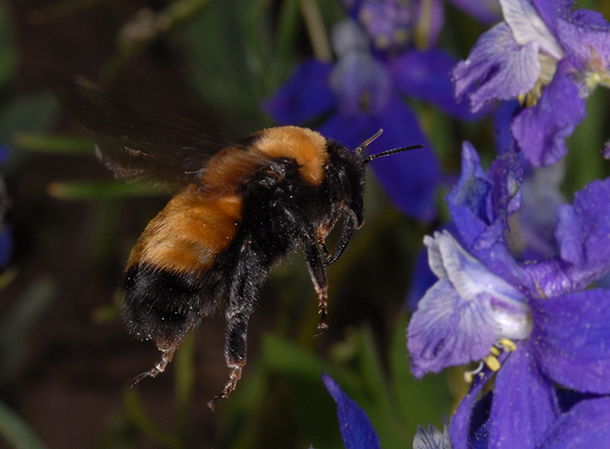
A Nevada bumblebee queen on a Barbey's larkspur flower in Colorado (Photo: David Inouye)
CURWOOD: Honeybees are in trouble. What other major pollinators around the world are doing badly at this point?
INOUYE: Well another major group of bees that are very important pollinators are the bumblebees and there are a couple of reasons why bumblebees have been having problems. One is that there is now international trade in bumblebees and unfortunately some of the providers that have been shipping bumblebees around the world have been shipping bees that have some disease problems or some parasite problems. Those bumblebees are often used for instance in pollinating tomato plants in the greenhouses it turns out. They need to be pollinated and the bumblebees are very good at it, honey bees are not. But when some of these diseased bumblebees are foraging inside greenhouses, they may fly out through the windows of greenhouses and come into contact with native bees, and so there's been what we call pathogen spillover. A couple of these introduced species of bumblebees have also escaped and become invasive. So in Japan there are now what were originally European bumblebees causing problems for the native bumblebees and the same has also happened in South America where some of their native species of bumblebees are at risk because of the introduced bumblebees.

A male Broadtailed Hummingbird in Colorado visits a flower of the red columbine (Photo: David Inouye)
CURWOOD: Professor Inouye, how much of a pollinator crisis are we facing around the world? How worried should we be about this in terms of not only our food supply but also the ecosystems throughout nature?
INOUYE: Well, we do know that we seem to be entering a sixth mass extinction event on the planet and that this one seems to be largely the result of human activities, and pollinators are not immune from that. We do know that some pollinators have gone locally extinct and in some cases they're very specialized relationships between pollinators and the plants they visit. For instance, each species of fig, and there are a number of different species of fig trees, has its own specialist wasp pollinator and so if that wasp pollinator becomes extinct that fig species may go extinct. And there are other wildflower species that also have quite specialized relationships with pollinators. Those are the cases that we're going to have to worry most about.
CURWOOD: So what can we do to better promote pollinator health around the world?

David Inouye is a biology professor from the University of Maryland and a co-author of the recent report on global pollinator health. (Photo: courtesy of David Inouye)
INOUYE: Well the good news is that we are recognizing that there are these problems and that in many cases these problems can be solved without a tremendous expense or tremendous effort. So, for instance, regulating the international trade of bumblebees or even within North America, restricting the trade so that bumblebees that were originally native to the eastern United States are not being shipped to the western US and and vice versa. Another thing that we can do is recognize that whether it's in our own yards or in agriculture that some of these pesticides are causing problems for bees and try to be more careful about their application or try to minimize their application or find alternatives to them. Another thing that we've learned is that even in urban areas there can be surprising numbers of pollinators, a surprising diversity of bees will do quite well in urban areas as long as they have access to flowers, and so if you're willing to take a little time and plant some appropriate wildflowers in your gardens or even in your yards in urban areas that can be a big boost to pollinator populations.
CURWOOD: David Inouye is a Biology Professor at the University of Maryland and one of the authors of the new UN-sponsored global survey on the help pollinators. Thank you so much, professor.
INOUYE: Thank you very much.
Related links:
- Report: Thematic assessment of pollinators, pollination and food production
- David Inouye is a Professor at the University of Maryland
- The Pollinator Partnership is an organization working to protect pollinators in the US
- The Pollinator Partnership publishes guides for what to plant in different regions to help pollinators
The Great California Almond Pollination
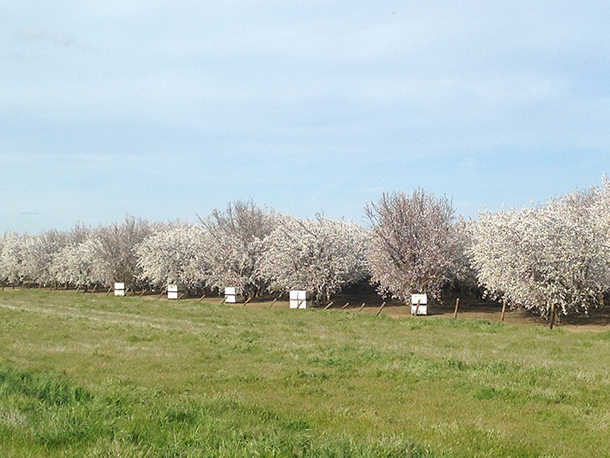
Beehives are spread out along rows of blooming almond trees. (Photo: Emmett Fitzgerald)
CURWOOD: The Central Valley of California could still use more water, but there was enough to cause thousands of acres of irrigated almond orchards to burst into flower for a couple of weeks in February. And with the blossoms came the beekeepers and their insects. Living on Earth’s Emmett FitzGerald took a road trip.
[DRIVING]
FITZGERALD: Joe Del Bosque and I are driving through the San Joaquin Valley. He’s an almond farmer, and he owns several plots of land scattered around this area.
DEL BOSQUE: I’m not one of those fortunate guys who you know when I came into farming my father had a big farm and just said you’re the new owner. I had to come in and I had to buy parcels and I bought one here and there.
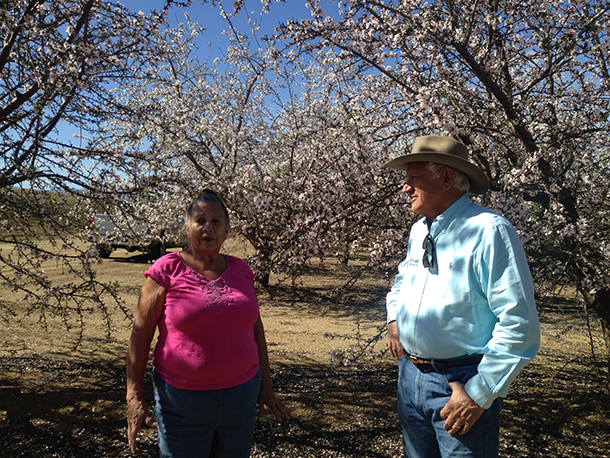
Beekeeper Rosemary Grissom and almond farmer Joe Del Bosque have been working together for over 30 years. (Photo: Emmett Fitzgerald)
FITZGERALD: In fact Joe’s parents were migrant farmworkers from Mexico who eventually settled in the San Joaquin valley. Joe worked as a supervisor on farms for years before deciding to go out on his own. He started off with melons and cotton.
DEL BOSQUE: But after I made money on melons and cotton then I had enough to start investing in these crops.
FITZGERALD: He points to the almond trees on either side of the truck covered in foamy white blossoms.
DEL BOSQUE: You put in a chunk of money to buy trees, buy the drip system, and then you have to wait about four years to get money back.
FITZGERALD: Now Joe has about 660 acres of almonds, and so far, that investment has paid off well. The Central Valley has a perfect climate for almonds, but they need a lot of help. The trees require irrigation 12 months out of the year, which turned them into something a drought villain in many people’s eyes. And during this crucial flowering period, they also need a lot of honeybees.
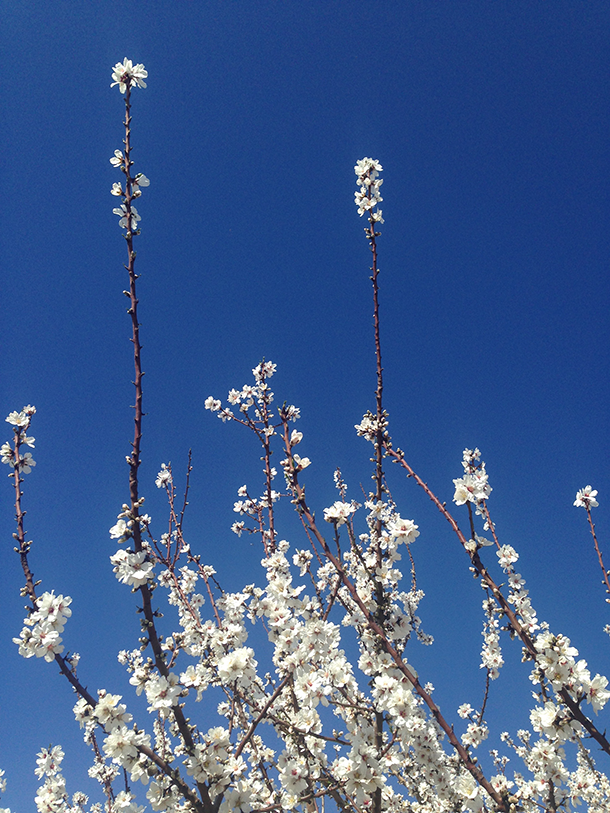
Almond blossoms in February (Photo: Emmett Fitzgerald)
DEL BOSQUE: A lot of crops won’t even make fruit without bees. So our almonds, our melons, those have to be pollinated by bees, they can’t pollinate themselves.
FITZGERALD: And that’s where Rosemary Grissom comes in.
DEL BOSQUE: Hopefully this is Rosemary. It is!
FITZGERALD: A stooped older woman with a weathered face gets out of a pickup truck by the side of the road. Rosemary has been Joe’s beekeeper for over 30 years.
DEL BOSQUE: So Rosemary and I have been working together I think since 1985, yeah.
FITZGERALD: She first got into beekeeping on a whim.
GRISSOM: Our friend needed somebody to help him so they talked my husband and I into helping him. And I was so scared. I wore my suit and taped everything up and looked like… I don’t know what.
FITZGERALD: But she’s been in the business for over 30 years now, and she’s not afraid of bees anymore.
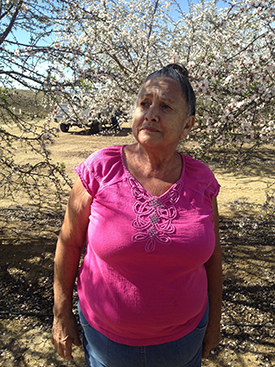
Rosemary Grissom is a beekeeper from the California’s San Joaquin Valley. (Photo: Emmett Fitzgerald)
GRISSOM: If you’re a calm person they don’t bother you. You go out there mad or erratic they’re going to get you. One time I was mad, and usually they don’t ever sting me and I had my shorts on and they were stinging me and I thought yeah I’m still mad. As soon as I quit being mad they stopped stinging me.
FITZGERALD: Rosemary’s husband Dale says when they first started he used to get stung all the time.
DALE: But then I don’t know it seemed like we work together with the bees and they calm right now. But you gotta watch sometime buying queens because they sometimes have what I call crazy blood in em, and they’re a real dark bee and boy they can be ornery those can. But these are the light red bees here and they’re real calm.
[BEES BUZZING]
FITZGERALD: We’re standing next to a cluster of bee boxes stacked at the end of a long row of almond trees. This February Joe rented about 1,500 hives from Rosemary for $180 dollars apiece. When Joe’s trees begin to bloom Dale and Rosemary bring the bees to the orchard in the middle of the night.
GRISSOM: Because in the daytime they’re flying. If you go too early you leave all the bees out here and I don’t think Joe’s people would be too happy.
JOE: You gotta move them when they’re back in their homes.
FITZGERALD: Rosemary and Dale use a forklift to spread the boxes throughout the orchard so the bees can pollinate all of the trees.
There are about 6,500 almond farms in California’s Central Valley, and they produce upwards of 80% of the world’s almonds. There aren’t nearly enough local bees (wild or domesticated) to pollinate all those flowers, so when the almond trees start to bloom, beekeepers from all over the country descend on the Central Valley.
GRISSOM: You can see the trucks coming from out of state. They come from as far as Florida because that’s their bread and butter. The guy right here is from Idaho, my other friend over there is from Arkansas, they come from everywhere, Mississippi…
FITZGERALD: In all over 1,500 beekeepers make the trip, and they bring billions of bees with them. It’s the largest controlled pollination in the world. When the almonds finish blooming, some of these beekeepers will take their hives on to pollinate other crops—cherries in Washington State, squash in Texas, cranberries in Wisconsin. Rosemary says that a lot of people assume that beekeepers make a living from honey, but that actually renting out their bees to farmers is very common. And it’s how she pays the bills.
GRISSOM: The almonds is the bread and butter. The other is just, if you make any honey it’s bonus.
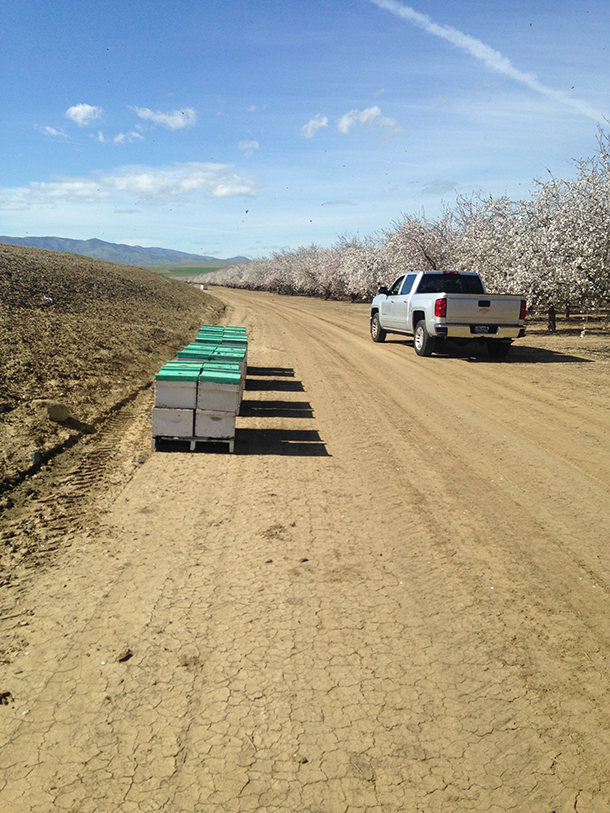
Some of Rosemary’s hives (Photo: Emmett Fitzgerald)
FITZGERALD: But recently beekeepers like Rosemary have been struggling to cope with the widely reported but still mysterious phenomenon known has Colony Collapse Disorder, which has devastated bee populations throughout the country. Rosemary says that every year it seems like one of her friends gets hit.
GRISSOM: Three years ago it was our turn and we had these two yards and there was 240 in each yard, hives, well I went in December and one day this one was gone and that one. It took all of them, they died. You’d go and there would be a queen and like ten bees.
FITZGERALD: Scientists say that disease and parasites have weakened hives, and recent studies have linked bee decline with the use of pesticides called neonicotinoids. Joe Del Bosque says he tries to use products that are friendly to bees and only apply them at night when the insects are in their hive. And whatever he does he gives Rosemary plenty of warning.
DEL BOSQUE: My pest control advisor is in constant communication with her so that she can determine, if we’re using a material that’s not dangerous to bees or if it is dangerous what they need to do. In some cases they cover up the bees in some cases we move them out.
FITZGERALD: For her part, Rosemary says she just has to plan for the worst and create extra hives.
GRISSOM: We just make more bees like this last year instead of making say 500 new ones we made like 800 because you don’t know how many you’re going to lose in the winter. And then sometimes that doesn’t even cover it.
FITZGERALD: So far this year her bees are doing pretty well. After the almond bloom ends, she’ll take them over to pollinate Joe’s melons. As for Joe, he’s going to keep on growing almonds. Prices are low right now, but they’re still a lucrative crop that he’s invested a lot of money into. But the future is less certain. Almonds need a lot of water, and a lot of bees, and both right now are in short supply.
For Living on Earth this is Emmett Fitzgerald in the San Joaquin Valley.
Related links:
- Del Bosque Farms
- Photos of American Migratory Beekeepers
- Report on the Impacts of Agriculture on the California Drought
- The Mind Boggling Math of Beekeeping Migration
[MUSIC: Steven Rosen/Richard Goering, "Raisins & Almonds," on Pinch of Oy a Dash of Ahh! a Bissel Krectser a Bissel Kveller, traditional Yiddish/arr.Goldfaden, CD Baby.com/Indy's]
CURWOOD: Coming up...why a good cup of coffee depends on more than just taste. That's just ahead on Living on Earth. Stay tuned.
ANNOUNCER: Funding for Living on Earth comes from United Technologies, a provider to the aerospace and building systems industries worldwide. UTC Building & Industrial Systems provides building technologies and supplies container refrigeration systems that transport and preserve food and medicine with brands such as Otis, Carrier, Chubb, Edwards and Kidde. This is PRI, Public Radio International.
[CUTAWAY MUSIC: Charlie Haden/Hank Jones, "Nobody Knows the Trouble I've Seen," on Steal Away, traditional African-American spiritual, Universal Music Group International and Decca Records France]
Good Bacteria Could Save Amphibians

The Appalachian Mountains are the world’s hotspot of salamander diversity, and home to this Cow Knob Salamander, Plethodon punctatus, from George Washington National Forest, Virginia. (Photo: Matt Becker)
CURWOOD: It's Living on Earth, I'm Steve Curwood. Around the world, fungal diseases have been killing millions of frogs and bats and snakes. And a newly emerging disease in salamanders in Europe is scaring biologists here, so the US Fish and Wildlife Service has introduced a ban on their import to try to protect amphibians in the US. But now scientists see some hope in soil bacteria that get onto the salamanders and frogs and apparently protect them. Doug Woodhams is an assistant professor of biology at UMass Boston, who’s been working with amphibians in Panama – and he explained what his team has found to Living on Earth’s Helen Palmer.
PALMER: Now, you've been looking at the kind of fungal diseases that attack frogs and salamanders and you’ve found some good news.
WOODHAMS: Yes, so some of the amphibians have beneficial bacteria that live on their skin and these have antifungal properties.

A researcher swabs a red-legged frog to check for chytrid fungus. (Photo: kqedquest, Flickr CC BY-NC 2.0)
PALMER: This is kind of like having good bacteria in your gut, for instance, that stop you from getting sick.
WOODHAMS: Exactly, yeah, so the amphibian skin is a mucosal surface just like our guts and they are also protected by microbiota.
PALMER: Is there any evidence that these good bacteria actually work against these devastating funguses?
WOODHAMS: Yeah there's quite a bit of evidence. Many of the bacteria that we can culture from some amphibian species are able to inhibit the fungus in culture. We also have some population level data that shows populations that tend to have these antifungal bacteria can persist with Bd in the environment and survive.
PALMER: Bd is?
WOODHAMS: Bd is the chytrid fungus that’s been spreading around the world and devastating amphibian populations. So salamanders, frogs, toads. So populations that tend to have more of these beneficial bacteria seem to be surviving, and populations that don't have as many of the individuals that have these bacteria seem to disappear.
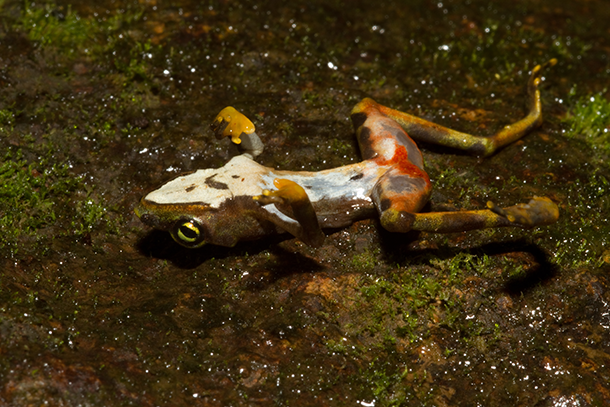
The chytrid fungus, Bd, has been linked to declines in at least 200 amphibian species. (Photo: Brian Gratwicke, Flickr CC BY 2.0)
PALMER: What are these bacteria? What kind of bacteria are they?
WOODHAMS: We'll they're many different kinds, for example, Pseudomonas is one kind that we find on the skin.
PALMER: That's something that makes people sick.
WOODHAMS: Yeah, there are many different strains and some of them can affect humans, but others are beneficial and they can occur in the water and soil, but they can also occur on the amphibian skin and they produce antibiotic compounds.
PALMER: And you're finding these working? What are they actually doing?
WOODHAMS: With the bacteria they can produce secondary metabolites, so they probably use these in competition with each other, but they also can be antifungal and inhibit the growth of the chytrid fungus. Some of them, what we most recently discovered as I think is one of the more exciting things is that they're producing volatile compounds, so not only compounds that are soluble through the water but things that can be airborne and affect chytrid fungus at a distance. So, for example, one of the Pseudomonas bacteria produces hydrogen cyanide and that's antifungal as well as can kill other organisms as well.

C. euknemos is one of many frog species threatened by chytrid fungus. (Photo: Doug Woodhams)
PALMER: Yeah, it's pretty toxic.
WOODHAMS: That's right.
PALMER: It doesn't seem to kill the hosts, the amphibians it's on.
WOODHAMS: That's right it probably doesn't occur in high enough concentrations to affect the amphibians.
PALMER: This is actually as you say very exciting. Is this a kind of approach that could work for other fungal diseases, I mean besides the ones on salamanders and frogs.
WOODHAMS: Yeah it's interesting you mention that because we actually originally heard about a Rhodococcus species of bacterium that was found associated with bats and could inhibit the White-nosed syndrome, and this Rhodococcus was found on amphibian skin so we decided to test it against Bd and it turns out it's also antifungal and can kill Bd.
PALMER: So, the newly emerging variation on the chytrid fungus that seems to be affecting salamanders, Fish and Wildlife has brought in regulations to prevent the import of salamanders from Europe. Do you think these have worked so far to keep the salamander disease out?
WOODHAMS: So far there's no evidence that the salamander chytrid or Bsal, so far there's no evidence that that chytrid has arrived, so hopefully the new regulations will prevent a lot of imports of salamanders and newts from Europe and Asia that might be harboring the fungus.
PALMER: We've seen the chytrid fungus that affects frogs spread all round the world and wiped out massive amounts particularly of certain frogs. If the salamander fungus is not here, then presumably the danger is that once it gets here it will have a similarly devastating effect because they won't have any immunity.
WOODHAMS: Absolutely, and that's why - it may be only a matter of time before it arrives, so that's why there's a recent increase in the concern and research activity trying to figure out which amphibians which salamanders, even frogs may be susceptible - we don't know yet - and especially in Appalachians where it's the world's hotspot of biodiversity. We really want to keep this new salamander chytrid out and if we can't then we need some tools, for example, probiotics or antifungal treatments that may be able to help.
PALMER: How important are salamanders in the ecosystem? I mean, we all love them, they're cute little things, but do they have a really vital role in the ecosystem?

The discovery of bacteria that combat the fungus involved in white-nose syndrome in bats inspired Professor Woodhams and his team to study how good bacteria may help amphibians fight off chytrid fungus. (Photo: U.S. Fish and Wildlife Service Headquarters, Flickr CC BY 2.0)
WOODHAMS: They do, and in fact in some areas of the Appalachians, the biomass of the salamanders outweighs even all the other vertebrates combined, and people don't tend to see them but I think they're very beautiful and they often come out at night and so many people don't know that they're even there.
PALMER: So they're really vital in the ecosystem and we run the risk of losing a lot of them should this disease come here. Is there any way to kind of inoculate wild salamanders against it?
WOODHAMS: I'm not sure. It's a possibility but right now I think that the research is really focused on what we can do in a captive setting, whether it's captive raised amphibians that will be re-introduced or maybe things that come in and have to go through a quarantine period. Maybe they could be treated, for example, with beneficial bacteria and then they could go on. But as far as treating wild populations, I think that's more difficult and we need more research to determine if that's going to be effective.
PALMER: But presumably we could work on captive ones in the lab, see what we can make work, and then work out whether there's any way to introduce it. But, yeah, I mean if they have soil bacteria, maybe they're there already.
WOODHAMS: Yeah, absolutely and that's one of things I try to emphasize is that the work that I'm doing I would never want to introduce a new bacterium or a new potential pathogen to an area where it didn't exist before. We want to prevent novel introductions of species, and so what we're working on is finding beneficial bacteria that already exists in populations and either augmenting those populations on susceptible frogs and salamanders or adding it to the habitat where it's already found.

Doug Woodhams studies disease ecology and teaches at the University of Massachusetts Boston. (Photo: Harry Brett)
PALMER: So, where does this research go next for you?
WOODHAMS: Well, the next thing we want to try is adding some of these bacteria, not just to petri dishes, but to soil and see if infected amphibians can be cleared of their infection by being housed on soil that's been inoculated with these bacteria. It might even be something...there are these other fungal pathogens so it could be something that you could apply in a cave that could reduce White-nosed syndrome, also rattlesnakes have been recently affected by fungal disease during hibernation so it could be applied into a rattlesnake den, for example.
CURWOOD: That’s UMass Boston biology professor Doug Woodhams, who told Living on Earth’s Helen Palmer about the new discoveries that might help save salamanders and perhaps other wildlife under threat from fungal diseases.
Related links:
- Dr. Woodhams’ paper, “Managing Amphibian Disease with Skin Microbiota”
- About Bd and other chytrid fungi
- About the Bsal salamander fungus
- Dr. Doug Woodhams’ lab
- Elizabeth Kolbert, “What’s Causing Deadly Outbreaks of Fungal Diseases in World’s Wildlife?”
[MUSIC: Jerry Garcia and David Grisman, "There Ain't No Bugs On Me," on Not For Kids Only, traditional American, Acoustic Disc]
Sustainable Coffee Keeps the Planet in the Black

More than half of American adults drink coffee every day. (Photo: Steve Corey, Flickr CC BY-ND 2.0)
CURWOOD: A cup of joe might help sustain your energy, but it may not be so sustainable for the Earth. Just 12 percent of coffee is sold under the label "sustainably grown." A new initiative called the Sustainable Coffee Challenge aims to change the way the coffee industry operates to the benefit of the Earth. Peter Seligmann is chairman, CEO, and co-founder of Conservation International, which is leading the charge, and he joins us in the studio now. Peter, welcome back to Living on Earth.
SELIGMANN: Thank you so much. It's good to be here.
CURWOOD: So tell me about the sustainable coffee challenge that CI has just formed. Why did you zero in on coffee as a target for sustainability?
SELIGMANN: Well, we started working on coffee about 15 years ago with Starbucks, and after 15 years we've been able to announce with Starbucks that 99 percent of all their coffee is certifiably sustainably harvested and produced. Which means that as their company has grown they have not cut a single tree, and hundreds of thousands of hectares of forests have been set aside as Starbucks has expanded its coffee business. That inspired us to think, is it possible to make coffee the first agricultural commodity that is completely and 100 percent sustainably produced.
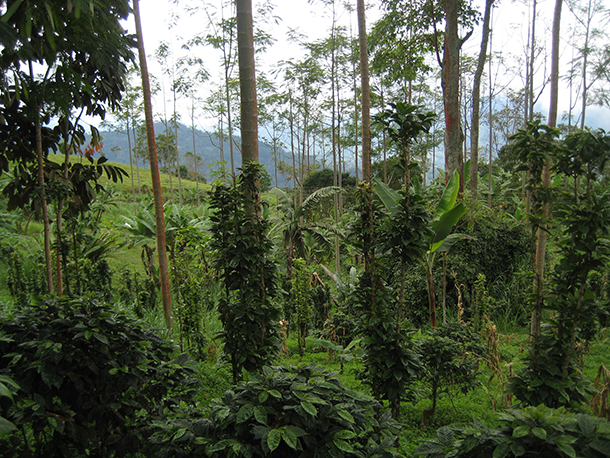
Shade-grown coffee leaves most of the forest intact, preserving wildlife habitat and soil quality. (Photo: U.S. Fish and Wildlife Service Northeast, Flickr CC BY 2.0)
CURWOOD: What's the dark side of coffee growing?
SELIGMANN: The dark side of coffee growing is that coffee that is not produced under the shade of forest, that coffee is actually produced by clear-cutting forests and planting coffee, and when you clear-cut a forest you destroyed the biodiversity, you put emissions, CO2 emissions in the atmosphere, you loose soil and actually, you do industrial grade culture, and industrial agriculture maximizes the pesticides, chemicals and reduces the benefits to society.
CURWOOD: So, what's the obstacle to growing coffee sustainably?
SELIGMANN: It's convincing the producers that this is in their enlightened self-interest. To go from non-sustainable coffee to sustainable coffee requires an investment of money and it requires time. Most of these growers, farmers actually work in co-ops, and the challenge is getting the co-ops to agree that this is the transition they want to make from non-sustainable to sustainable and what's going to motivate them is there being a buyer for the coffee they grow. And so it gets back to the consumer, and the consumer says it's what we want, and then the retailer says, “OK that's what we're going to supply” and then the retailer goes to the producer and says we need coffee that's rainforest friendly, you will end up with a motivated grower, a motivated supplier, a motivated retailer and a consumer that's happy.
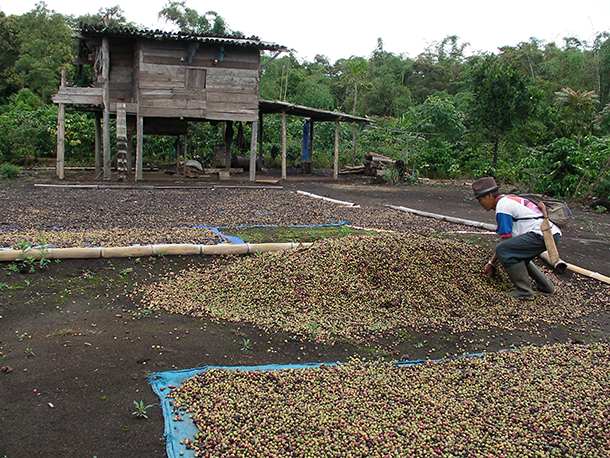
Coffee beans dry in a remote village in Indonesia, where unsustainable growing practices have destroyed some parts of the forest. (Photo: Rainforest Action Network, Flickr CC BY-NC 2.0)
CURWOOD: Now, at Conservation International you work with a number of other businesses, I'm thinking in particular, Walmart. What's the core of your initiative with them?
SELIGMANN: Well, Wal-Mart is a very important strategic partner if you want to change the way the world operates. It is one of the largest corporations in the world and it has about 150,000 companies that supply goods and services to Wal-Mart that then sell to their customers. So we pick Wal-Mart to try to transform the way Wal-Mart behaved because we thought if we could get Wal-Mart to change they would in turn get their 150,000 suppliers to change. And the argument we made with Wal-mart about a decade ago was in Wal-Mart's enlightened self-interest to reduce waste and to secure their supply chain. That, we said, would save them money and provide them with security for their business and security for their customers. And so Wal-Mart jumped on it. The CEO Lee Scott said to me, "I had my first grandchild last year. I want to do the right thing. Help us." And the employees said, "Are you telling us we can come out of the closet about being environmentalists?" And think about the atmosphere at Wal-Mart a decade ago. Everybody was assaulting them and they were feeling under siege and they wanted to say, "We're good people. We are a great company." And so they embrace this. They deserve a lot of credit for it. Now, they have saved hundreds of millions of dollars doing this. And so their motivation was kind of a combo of what's right for our heart and what's right for society and what's right for bottom line. And that synergy is what is important, not just for Wal-Mart, but that's a synergy that make businesses hum.
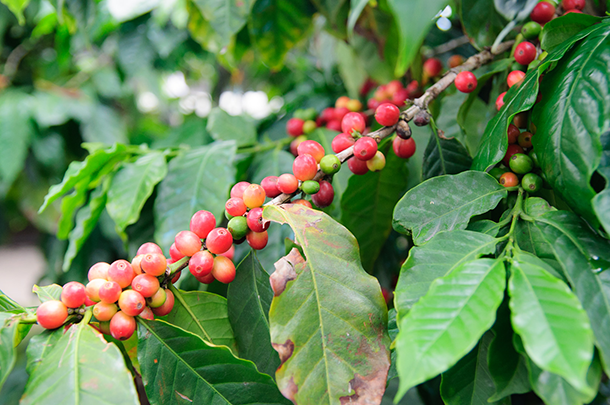
Coffee beans are the pits inside the fruit or “cherry” of the coffee plant. (Photo: Martin Diepeveen, Flickr CC BY-NC-ND 2.0)
CURWOOD: Doing well by doing good.
SELIGMANN: Exactly right. And if you think about the Paris negotiations, what was most encouraging for me in Paris was the extraordinary enthusiasm of the private sector to be engaged in reducing CO2 and protecting ecological systems because it was good for the businesses. That's what made this a successful climate negotiation.
CURWOOD: So what prompted you, Peter Seligmann, the founder of Conservation International. You've been at this for more than three decades. What prompted you to change your business model from going around the world and identifying really important biological diversity hotspots and arranging for protections for them to reach out and deal with the business world?
SELIGMANN: Well, societies, nations have to have jobs and anything that threatens the livelihoods of people is a hard thing to get societies to embrace. I felt that it was really important for us to explore how can societies take care of nature and thrive economically simultaneously because if you don't take care of nature, you lose your underpinnings that allow us to live - water and air and food - and if you don't have jobs, you have poverty and you have disadvantaged people, you don't have educational systems and your society collapses. So clearly, you can't choose between one or the other. You have to have both. And when I realized that I thought our organization at Conservation International, we could actually decide to pick a path to focus on. What are the contributions that nature makes for the well-being of humanity and how do you get businesses and societies to understand that it is in their enlightened self-interest to actually take care of natural systems.
CURWOOD: How do you protect the forests though and keep the jobs and employment local so that the cash flow works for everybody from the local peasant or indigenista right on up through the economic food chain?
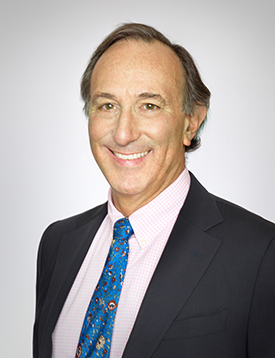
Peter Seligmann is CEO and co-founder of Conservation International. (Photo: Conservation International)
SELIGMANN: Well, if you go into a forest and you log it, and your revenues and your income comes from logging, you get one cut and you're done and then you move on to the next place. That's not creating jobs. That's basically destroying ecological systems, destroying your source of biodiversity, your fresh water. It's emitting CO2. It's a terrible strategy and creates poverty and unhappiness. However, if you take that same forest and you say we're going to grow coffee beneath that forest, then you have a forest that's there forever, you have jobs from coffee production that are there forever, you have better education, you have better livelihood, you have more stable families and you can look at this from the perspective of coffee as a source of livelihood, you can look at tourism and people that visit to see the nature and the wonder of the lemurs or the primates or the wildlife. You can look at it from any number of different types of jobs and commodities that are grown without destroying a forest. In other words, protecting forests is the smartest way to reduce emissions and to create jobs for nations.
CURWOOD: Peter Sullivan is CEO and co-founder of Conservation International. Thanks so much for taking the time today, Peter.
SELIGMANN: Wonderful to be here. Thank you.
Related links:
- Sustainable Coffee Challenge
- Ethical coffee sourcing at Starbucks
- Sustainability at Walmart
- About Peter Seligmann
- Listen to a previous Living on Earth discussion with Peter Seligmann
[MUSIC: Bill Frisell and ensemble, "Listen," on The Intercontinentals, Nonesuch]
CURWOOD: Living on Earth is produced by the World Media Foundation. Our crew includes Naomi Arenberg, Bobby Bascomb, Emmett Fitzgerald, Lauren Hinkel, Helen Palmer, Adelaide Chen, Jenni Doering, Peter Boucher, Jaime Kaiser, Jolanda Omari and Jennifer Marquis. Tom Tiger engineered our show, with help from Jeff Wade, Jake Rego and Noel Flatt. Alison Lirish Dean composed our themes. You can find us anytime at LOE.org - and like us, please, on our Facebook page - it’s PRI’s Living on Earth. And we tweet from @LivingonEarth. I'm Steve Curwood. Thanks for listening!
ANNOUNCER1: Funding for Living on Earth comes you, our listeners, and from the University of Massachusetts Boston, in association with its School for the Environment, developing the next generation of environmental leaders. And from the Grantham Foundation for the protection of the environment, supporting strategic communications and collaboration in solving the world’s most pressing environmental problems. And Gilman Ordway for coverage of conservation and environmental change. And from SolarCity, America’s solar power provider. Solar city is dedicated to revolutionizing the way energy is delivered by giving customers a renewable alternative to fossil fuels. Information at 888-997-1703. That’s 888-997-1703.
ANNOUNCER2: PRI. Public Radio International.
Living on Earth wants to hear from you!
Living on Earth
62 Calef Highway, Suite 212
Lee, NH 03861
Telephone: 617-287-4121
E-mail: comments@loe.org
Newsletter [Click here]
Donate to Living on Earth!
Living on Earth is an independent media program and relies entirely on contributions from listeners and institutions supporting public service. Please donate now to preserve an independent environmental voice.
NewsletterLiving on Earth offers a weekly delivery of the show's rundown to your mailbox. Sign up for our newsletter today!
 Sailors For The Sea: Be the change you want to sea.
Sailors For The Sea: Be the change you want to sea.
 The Grantham Foundation for the Protection of the Environment: Committed to protecting and improving the health of the global environment.
The Grantham Foundation for the Protection of the Environment: Committed to protecting and improving the health of the global environment.
 Contribute to Living on Earth and receive, as our gift to you, an archival print of one of Mark Seth Lender's extraordinary wildlife photographs. Follow the link to see Mark's current collection of photographs.
Contribute to Living on Earth and receive, as our gift to you, an archival print of one of Mark Seth Lender's extraordinary wildlife photographs. Follow the link to see Mark's current collection of photographs.
 Buy a signed copy of Mark Seth Lender's book Smeagull the Seagull & support Living on Earth
Buy a signed copy of Mark Seth Lender's book Smeagull the Seagull & support Living on Earth

